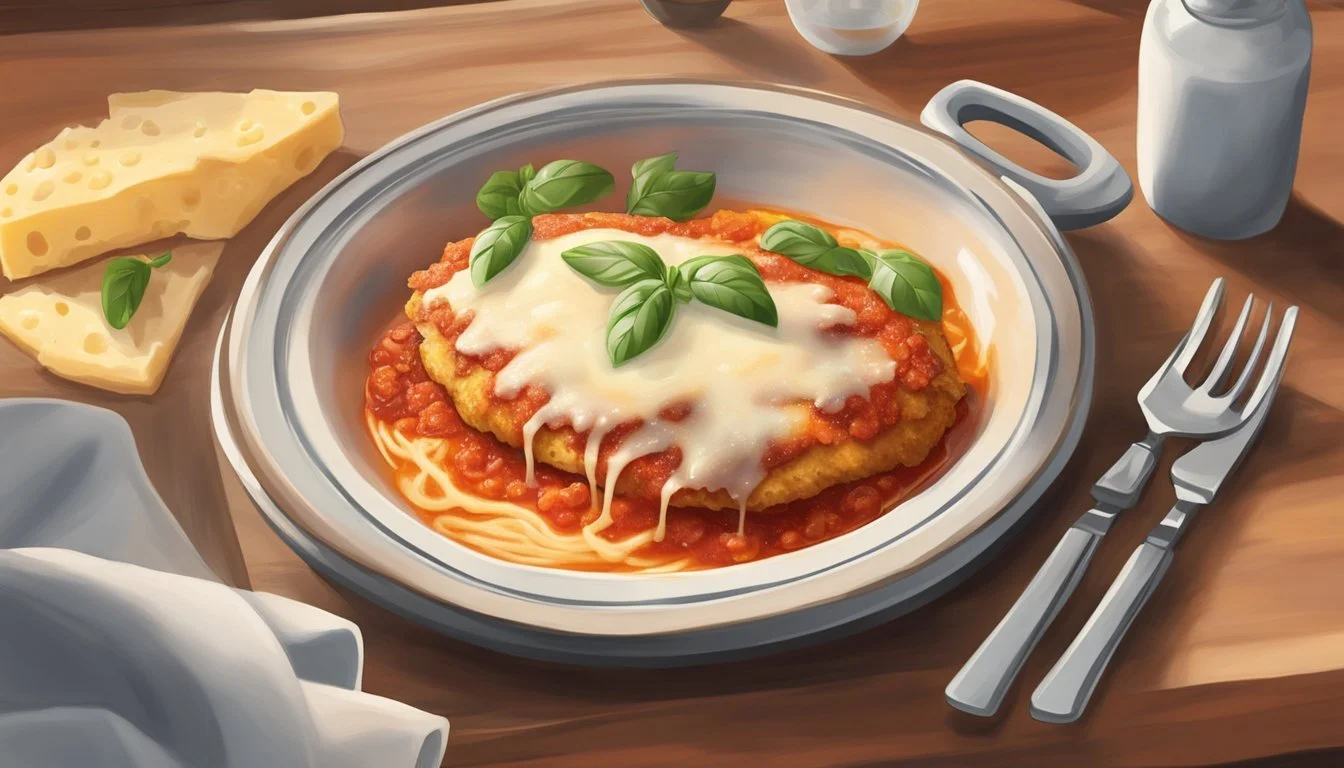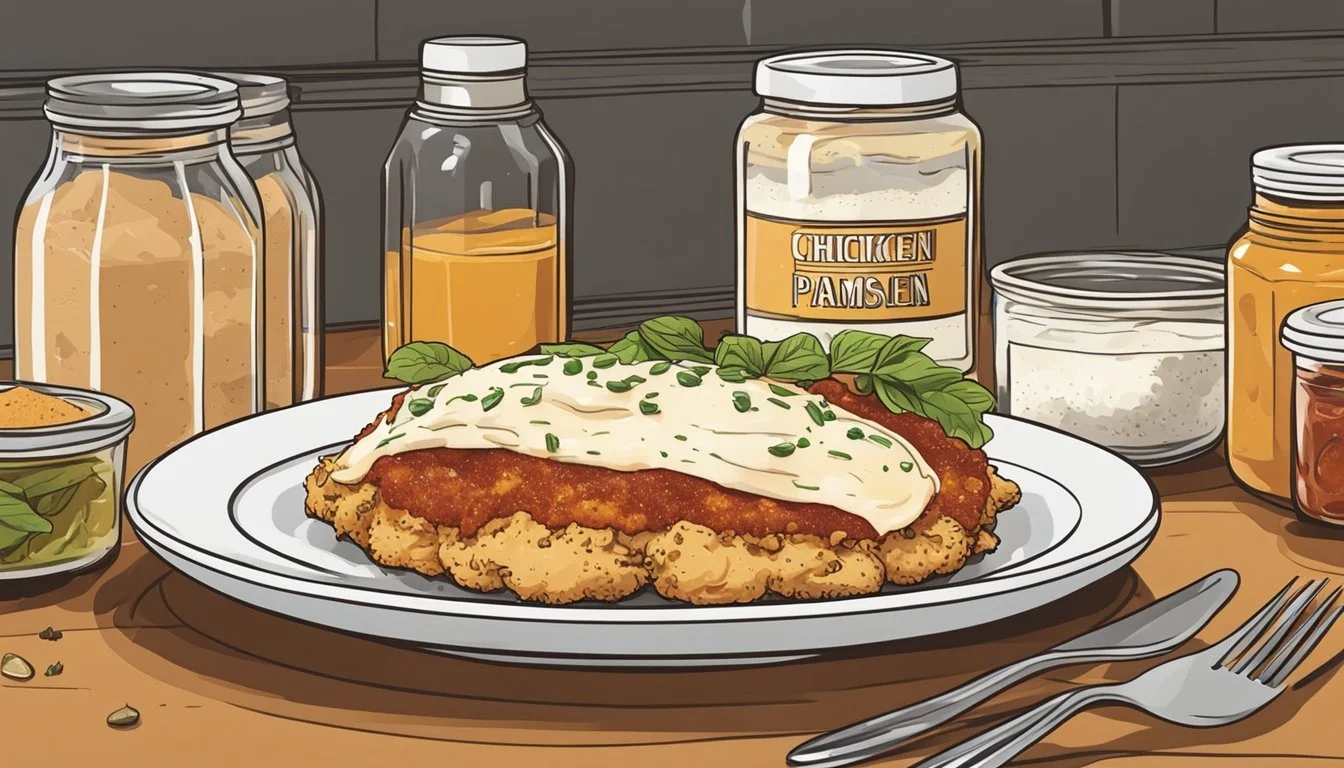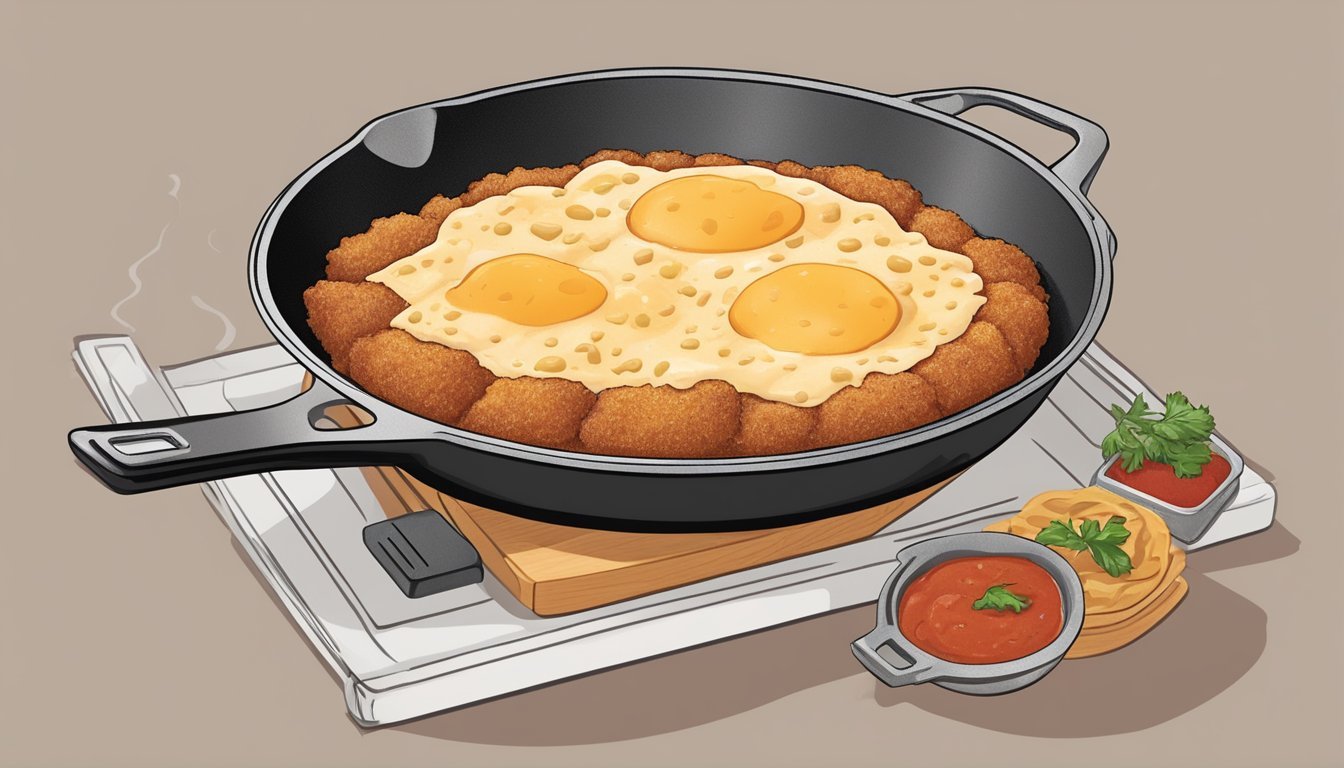How Long Does Chicken Parmesan Last?
Storage Tips and Guidelines
Chicken Parmesan, also fondly known as Chicken Parm or Parmigiana, is a beloved Italian-American dish that combines crispy breaded chicken cutlets with marinara sauce and melted cheese. This delightful combination makes for a comforting meal that many enjoy, whether freshly prepared or as leftovers. When stored properly in an airtight container, Chicken Parmesan can last up to 4 days in the refrigerator.
Ensuring the dish is stored correctly is key to maintaining its quality and safety. Before consuming any leftover Chicken Parm, it's essential to check for signs of spoilage, such as an off-odor or visible mold. These precautions can help prevent any foodborne illnesses and ensure the meal remains as enjoyable as when it was first made.
This popular dish's appeal lies in its flavors and textures—a crispy golden crust, tender chicken, and rich tomato sauce topped with melted cheese. Knowing how to safely store and reheat Chicken Parmesan means you can savor its deliciousness even days after it's been made, making it a versatile and convenient option for busy schedules.
Chicken Parmesan Overview
Chicken Parmesan is a classic Italian-American dish known for its delicious combination of flavors and textures. It prominently features crispy chicken breasts, rich tomato sauce, and a blend of cheeses.
What Is Chicken Parmesan?
Chicken Parmesan, also known as Chicken Parmigiana, is a beloved dish that combines breaded and fried chicken breasts with tangy tomato sauce and melted cheeses.
The chicken is typically dredged in all-purpose flour, dipped in eggs, and coated in breadcrumbs before being fried.
This process creates a crispy outer layer that contrasts beautifully with the tender chicken inside. Once fried, the chicken is topped with tomato sauce, mozzarella cheese, and parmesan cheese, then baked until the cheese is melted and bubbly. Often, it's served over spaghetti or another type of pasta.
Key Ingredients
Chicken Breasts: The main protein, often pounded thin for even cooking.
Tomato Sauce: Provides the base layer of flavor, balancing the dish with acidity and sweetness.
Mozzarella Cheese: Melts over the top, creating a gooey, indulgent texture.
Parmesan Cheese: Adds a nutty, salty finish that complements the other ingredients.
Breadcrumbs: Coated on the chicken to create a crispy exterior.
Eggs: Used to bind the breadcrumbs to the chicken breasts.
All-Purpose Flour: Helps the egg mixture stick to the chicken.
Spaghetti: Commonly served as a side to soak up the extra sauce and cheese.
Proper Storage Techniques
Proper storage of chicken Parmesan is crucial to maintaining its freshness, flavor, and safety. Different methods should be used depending on whether the chicken Parmesan will be consumed in the short term or if it needs to be stored for an extended period.
Short-Term Refrigeration
When planning to consume chicken Parmesan within a few days, storing it in the refrigerator is best. Cooked chicken Parmesan can last for up to four days in the fridge when kept in an airtight container.
Using airtight containers prevents the dish from absorbing any odors from other foods in the refrigerator. Alternatively, plastic wrap or aluminum foil can be used to cover the dish tightly, ensuring no air gets inside.
Placing the chicken Parmesan on a shelf in the fridge, rather than the door, ensures a consistent temperature is maintained. This helps to keep the dish fresh and prevents spoilage.
Long-Term Freezing
For long-term storage, freezing chicken Parmesan extends its shelf life to up to three months. Ensure the dish is completely cooled before placing it in the freezer.
Wrap the chicken Parmesan tightly using plastic wrap or aluminum foil. For optimal results, use a freezer-safe bag or an airtight container. Removing as much air as possible from the packaging prevents freezer burn, which can affect the dish's quality.
Label the container or bag with the date of freezing to keep track of how long it has been stored. Frozen chicken Parmesan can be reheated in the oven at 350°F (175°C) for approximately 20-25 minutes.
Best Practices for Wrapping
Effective wrapping techniques are essential to maintain the quality of chicken Parmesan during storage. When using plastic wrap, ensure the entire surface is covered with no exposed areas.
Alternatively, aluminum foil can provide a better barrier against moisture and air. For double protection, consider wrapping the chicken Parmesan first in plastic wrap and then in foil.
Airtight containers offer another reliable solution, especially for refrigerator storage. They prevent any air from entering, which maintains freshness and flavor. Always ensure the containers are completely sealed.
By following these storage techniques, chicken Parmesan can be enjoyed at its best, whether consumed soon after preparation or stored for future meals.
Shelf Life of Chicken Parmesan
Chicken Parmesan typically remains safe to consume for up to 4 days when stored in the refrigerator. It should be kept in an airtight container to maintain quality and prevent bacterial growth. Proper storage is crucial for extending its shelf life.
Key Factors Affecting Shelf Life
Preparation Method: The way chicken Parmesan is prepared influences its longevity.
Storage: Storing in an airtight container helps keep it fresh.
Signs of Spoilage
It's important to check for any signs of spoilage before consuming leftovers. These may include:
Off-Odor: A sour or strange smell indicates bacterial growth.
Discoloration: Any unusual colors on the chicken or cheese.
Texture Changes: Slimy or sticky consistency.
Avoiding Spoilage
To avoid spoilage, keep the chicken Parmesan in the fridge at or below 40°F (4°C). Reheat leftovers to an internal temperature of 165°F (74°C) to ensure they are safe to eat.
Freezing Chicken Parmesan
Freezing can extend the shelf life to 2-3 months. Use a freezer bag or an airtight container for best results. This helps preserve its taste and quality by reducing moisture loss and preventing freezer burn.
By carefully monitoring these factors, one can enjoy chicken Parmesan as a delicious, safe option within its recommended storage period.
Reheating Methods and Tips
To enjoy your chicken parmesan with a crispy exterior and warm, melty interior, it's essential to use the right reheating method. Different appliances and approaches can vary the results, so select one that suits your kitchen setup and preferences.
Oven Reheating
Reheating chicken parmesan in the oven ensures even heating and helps maintain the original texture.
Preheat the oven to 350°F (180°C).
Place the chicken parmesan on a wire rack with a drip tray underneath. This setup prevents the bottom from becoming soggy.
Cover the chicken loosely with aluminum foil to avoid drying out the cheese.
Bake for 15-20 minutes or until the internal temperature reaches 165°F (74°C).
Remove the foil for the last 5 minutes if desired, to brown the cheese.
Microwave Reheating
The microwave offers a quick way to reheat chicken parmesan, though it may result in a less crispy texture.
Place the chicken on a microwave-safe plate.
Cover it with a microwave-safe lid or paper towel to prevent drying and splattering.
Heat on 50% power for 2-3 minutes. Lower power settings help heat the chicken evenly.
Check the internal temperature; it should reach 165°F (74°C).
Continue heating in 30-second intervals if needed.
Stovetop Reheating
A skillet on the stovetop can deliver a crisp texture, especially if you use a bit of oil or butter.
Heat a non-stick skillet over medium heat.
Add a small amount of olive oil or butter to the pan.
Place the chicken parmesan in the skillet, cheese side up.
Cover the skillet loosely with a lid to retain moisture while allowing some steam to escape.
Heat for approximately 5-7 minutes or until the internal temperature reaches 165°F (74°C).
Flip the chicken once halfway through cooking if needed to ensure even reheating.
How Freezing Affects Quality
Freezing chicken parmesan can be an effective way to extend its shelf life. Properly frozen, it can last for 2-3 months in the freezer without significant loss of quality.
Freezing Process:
Cook and Cool: Chicken parmesan must be cooked and cooled before freezing.
Wrap: Use plastic wrap or foil to prevent freezer burn.
Container: Place wrapped portions in a freezer-safe container.
Impact on Taste:
When frozen correctly, chicken parmesan retains much of its original flavor. The cheese and sauce components may experience slight texture changes, but these are typically minimal if defrosting is done properly.
Freezer Burn:
Freezer burn occurs due to exposure to air and causes dry, tough spots on the food. To avoid this, ensure the chicken parmesan is tightly wrapped and stored in airtight containers.
Defrost in the refrigerator overnight for the best results. This method helps maintain texture and taste. Once thawed, reheat in the oven at 350°F (175°C) to ensure even warming. Avoid microwaving, as it can make the breading soggy.
Freezing offers convenience and helps minimize waste, but attention to packaging and defrosting methods ensures the best quality.
Cooking Chicken Parmesan
Cooking chicken parmesan properly involves preparation and baking. Ensuring the optimal mix of ingredients and achieving the right internal temperature are crucial for a tasty dish.
Preparation Instructions
Start by gathering all necessary ingredients: chicken breasts, flour, eggs, breadcrumbs, garlic powder, onion powder, salt, pepper, parmesan cheese, and mozzarella cheese. Three bowls are needed for breading. In the first bowl, mix flour, salt, pepper, and garlic powder. In the second, whisk eggs with some salt and pepper. The third bowl should contain a blend of Panko breadcrumbs, grated Parmesan cheese, garlic powder, onion powder, salt, and pepper.
Begin by dredging the chicken breasts in the flour mixture, ensuring each piece is evenly coated. Then dip them into the egg mixture. Lastly, press them firmly into the breadcrumb mixture, ensuring they are fully coated. Heat olive oil in a skillet over medium heat and cook the breaded chicken for 2-3 minutes on each side until golden brown.
Baking Guidelines
Preheat the oven to 350°F (175°C). Lightly grease a baking dish and place the browned chicken breasts inside. Top each piece with marinara sauce, ensuring they are well-covered. Sprinkle parmesan and mozzarella cheese generously over the top.
Bake the chicken for 25-30 minutes if pre-fried, or 45-50 minutes if using raw chicken. Check the internal temperature to ensure it reaches 165°F (74°C). Garnish with fresh basil just before serving to add a fresh touch. This method ensures that Chicken Parmesan is both tender and flavorful.
Nutritional Information
Chicken Parmesan is a dish with various nutritional components. Each serving size impacts calorie and nutrient intake.
On average, a standard serving size of Chicken Parmesan provides around 600-700 calories. This can vary based on how the dish is prepared and the specific ingredients used.
A typical 1/2 breast with sauce and cheese (about 254 grams) contains approximately:
Calories: 254
Fat: 12.38g
Carbohydrates: 12.18g
Protein: 22.83g
In some cases, a serving could be around 320 calories, requiring the following exercise to burn off:
Walking (3mph): 87 minutes
Running (6mph): 31 minutes
Bicycling (10mph): 45 minutes
Factors such as portion size, specific recipe variations, and cooking methods all influence these numbers. Adjustments to the recipe can alter the nutritional profile, making it a more flexible dish depending on dietary needs. Always consider these variables when assessing its nutritional content.
Common Variations and Substitutes
Chicken Parmesan, also known as Pollo alla Parmigiana, has many variations that cater to different tastes and preferences.
For a twist on the classic, some people use Provolone cheese instead of mozzarella. Provolone offers a sharper flavor, which can add depth to the dish.
Italian-American versions often feature rich marinara sauce as the base, enhancing the dish’s flavor profile.
In Australia, a popular variation known as Parmi can be found in pubs. This variation may include additional toppings, such as ham or bacon, for an extra layer of flavor.
For those looking for healthier options, baked chicken can replace the traditional fried version. This reduces calorie content without compromising on taste.
For substitutes, eggplant is a common option for a vegetarian twist, leading to Eggplant Parmesan. It offers a similar texture and absorbs flavors well.
To make gluten-free versions, almond flour can replace traditional breadcrumbs, maintaining the dish’s crunchy texture.
These alternatives and adjustments make Chicken Parmesan a versatile dish, adaptable to various dietary needs and preferences.







